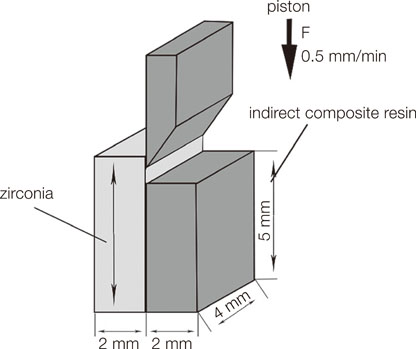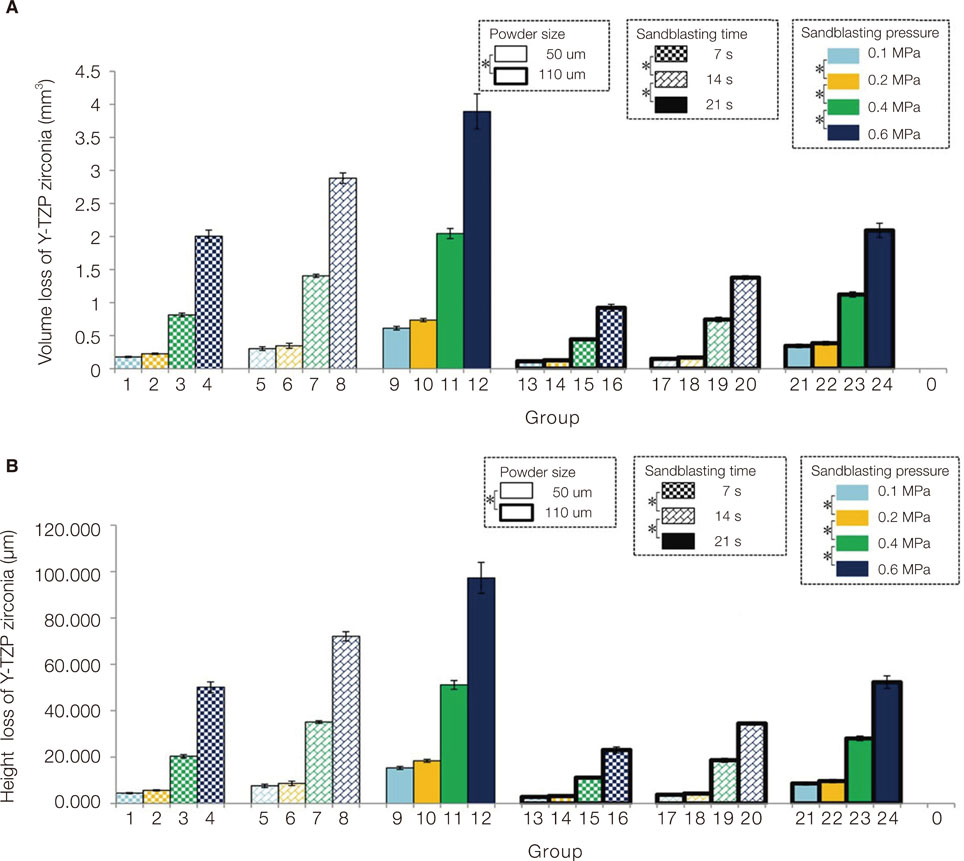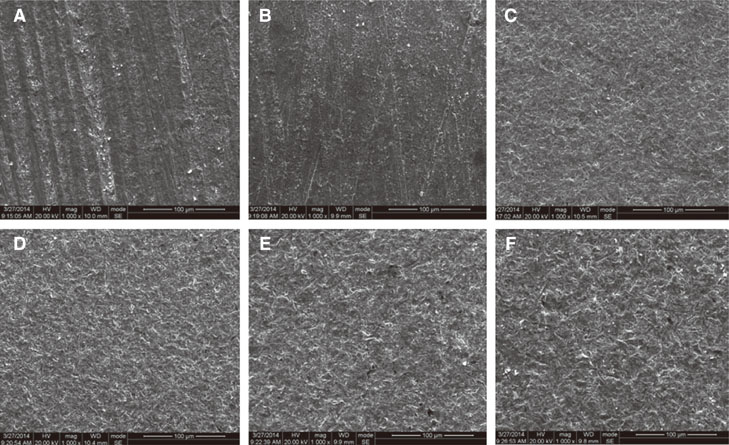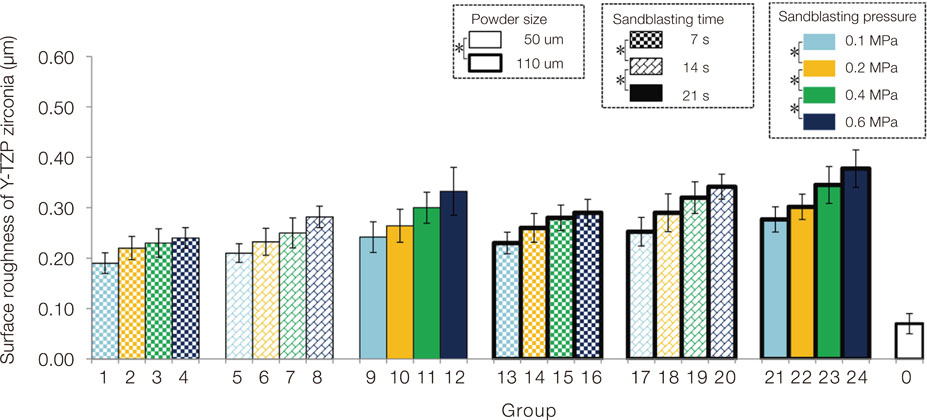J Adv Prosthodont.
2015 Jun;7(3):214-223. 10.4047/jap.2015.7.3.214.
The effect of various sandblasting conditions on surface changes of dental zirconia and shear bond strength between zirconia core and indirect composite resin
- Affiliations
-
- 1State Key Laboratory of Oral Diseases, West China Hospital of Stomatology, Sichuan University, Chengdu, P. R. China. wanghang@scu.edu.cn, shenjiefei@scu.edu.cn
- 2Department of Prosthodontics, West China School of Stomatology, Sichuan University, Chengdu, P. R. China.
- 3Department of Dental Technology, West China Hospital of Stomatology, Sichuan University, Chengdu, P. R. China.
- 4Department of Restorative Dentistry, School of Dentistry, University of Washington, Seattle, USA.
- 5Department of Stomatology, Mianyang Central Hospital, Mianyang, P. R. China.
- KMID: 2284707
- DOI: http://doi.org/10.4047/jap.2015.7.3.214
Abstract
- PURPOSE
To measure the surface loss of dental restorative zirconia and the short-term bond strength between an indirect composite resin (ICR) and zirconia ceramic after various sandblasting processes.
MATERIALS AND METHODS
Three hundred zirconia bars were randomly divided into 25 groups according to the type of sandblasting performed with pressures of 0.1, 0.2, 0.4 and 0.6 MPa, sandblasting times of 7, 14 and 21 seconds, and alumina powder sizes of 50 and 110 microm. The control group did not receive sandblasting. The volume loss and height loss on zirconia surface after sandblasting and the shear bond strength (SBS) between the sandblasted zirconia and ICR after 24-h immersion were measured for each group using multivariate analysis of variance (ANOVA) and Least Significance Difference (LSD) test (alpha=.05). After sandblasting, the failure modes of the ICR/zirconia surfaces were observed using scanning electron microscopy.
RESULTS
The volume loss and height loss were increased with higher sandblasting pressure and longer sandblasting treatment, but they decreased with larger powder size. SBS was significantly increased by increasing the sandblasting time from 7 seconds to 14 seconds and from 14 seconds to 21 seconds, as well as increasing the size of alumina powder from 50 microm to 110 microm. SBS was significantly increased from 0.1 MPa to 0.2 MPa according to the size of alumina powder. However, the SBSs were not significantly different with the sandblasting pressure of 0.2, 0.4 and 0.6 MPa. The possibilities of the combination of both adhesive failure and cohesive failure within the ICR were higher with the increases in bonding strength.
CONCLUSION
Based on the findings of this study, sandblasting with alumina particles at 0.2 MPa, 21 seconds and the powder size of 110 microm is recommended for dental applications to improve the bonding between zirconia core and ICR.
Keyword
MeSH Terms
Figure
Cited by 3 articles
-
The effect of sandblasting duration on the bond durability of dual-cure adhesive cement to CAD/CAM resin restoratives
Neslihan Tekçe, Safa Tuncer, Mustafa Demirci
J Adv Prosthodont. 2018;10(3):211-217. doi: 10.4047/jap.2018.10.3.211.The effect of zirconia surface architecturing technique on the zirconia/veneer interfacial bond strength
Soo-Bok Her, Kyoung Hun Kim, Sang Eun Park, Eun-Jin Park
J Adv Prosthodont. 2018;10(4):259-264. doi: 10.4047/jap.2018.10.4.259.Nonthermal plasma on the shear bond strength of relining resin to thermoplastic denture base resin
Manaloto-Ceballos Liezl, Wilmart Labriaga, So-Yeon Song, Jin-Hong Park, Jeong-Yol Lee, Sang-Wan Shin
J Korean Acad Prosthodont. 2018;56(3):199-205. doi: 10.4047/jkap.2018.56.3.199.
Reference
-
1. Dong JK, Luthy H, Wohlwend A, Schärer P. Heat-pressed ceramics: technology and strength. Int J Prosthodont. 1992; 5:9–16.2. Luangruangrong P, Cook NB, Sabrah AH, Hara AT, Bottino MC. Influence of full-contour zirconia surface roughness on wear of glass-ceramics. J Prosthodont. 2014; 23:198–205.3. Choi JE, Waddell JN, Torr B, Swain MV. Pressed ceramics onto zirconia. Part 1: Comparison of crystalline phases present, adhesion to a zirconia system and flexural strength. Dent Mater. 2011; 27:1204–1212.4. Lawn BR, Pajares A, Zhang Y, Deng Y, Polack MA, Lloyd IK, Rekow ED, Thompson VP. Materials design in the performance of all-ceramic crowns. Biomaterials. 2004; 25:2885–2892.5. Lawna BR, Denga Y, Miranda P, Pajares A, Chai H, Kim DK. Overview: Damage in brittle layer structures from concentrated loads. J Mater Res. 2002; 17:3019–3036.6. Sailer I, Fehér A, Filser F, Lüthy H, Gauckler LJ, Schärer P, Franz Hämmerle CH. Prospective clinical study of zirconia posterior fixed partial dentures: 3-year follow-up. Quintessence Int. 2006; 37:685–693.7. Sailer I, Fehér A, Filser F, Gauckler LJ, Lüthy H, Hämmerle CH. Five-year clinical results of zirconia frameworks for posterior fixed partial dentures. Int J Prosthodont. 2007; 20:383–388.8. Scurria MS, Bader JD, Shugars DA. Meta-analysis of fixed partial denture survival: prostheses and abutments. J Prosthet Dent. 1998; 79:459–464.9. Kim BK, Bae HE, Shim JS, Lee KW. The influence of ceramic surface treatments on the tensile bond strength of composite resin to all-ceramic coping materials. J Prosthet Dent. 2005; 94:357–362.10. Taira Y, Hatono H, Tokita M, Sawase T. Thickness and surface structure of a ceramic layer created on three indirect resin composites with aerosol deposition. J Prosthodont Res. 2010; 54:168–172.11. Kirmali O, Barutcugil C, Harorli O, Kapdan A, Er K. Resin cement to indirect composite resin bonding: Effect of various surface treatments. Scanning. 2015; 37:89–94.12. Leinfelder KF. Indirect posterior composite resins. Compend Contin Educ Dent. 2005; 26:495–503.13. Takahashi Y, Hisama K, Sato H, Chai J, Shimizu H, Kido H, Ukon S. Probability of failure of highly filled indirect resin-veneered implant-supported restorations: an in vitro study. Int J Prosthodont. 2002; 15:179–182.14. Nandini S. Indirect resin composites. J Conserv Dent. 2010; 13:184–194.15. Ereifej N, Silikas N, Watts DC. Edge strength of indirect restorative materials. J Dent. 2009; 37:799–806.16. Tsitrou EA, Northeast SE, van Noort R. Brittleness index of machinable dental materials and its relation to the marginal chipping factor. J Dent. 2007; 35:897–902.17. Ciftçi Y, Canay S. The effect of veneering materials on stress distribution in implant-supported fixed prosthetic restorations. Int J Oral Maxillofac Implants. 2000; 15:571–582.18. Kobayashi K, Komine F, Blatz MB, Saito A, Koizumi H, Matsumura H. Influence of priming agents on the short-term bond strength of an indirect composite veneering material to zirconium dioxide ceramic. Quintessence Int. 2009; 40:545–551.19. Blatz MB, Sadan A, Kern M. Resin-ceramic bonding: a review of the literature. J Prosthet Dent. 2003; 89:268–274.20. Guazzato M, Albakry M, Quach L, Swain MV. Influence of surface and heat treatments on the flexural strength of a glass-infiltrated alumina/zirconia-reinforced dental ceramic. Dent Mater. 2005; 21:454–463.21. Wang G, Zhang S, Bian C, Kong H. Effect of zirconia surface treatment on zirconia/veneer interfacial toughness evaluated by fracture mechanics method. J Dent. 2014; 42:808–815.22. Liu D, Matinlinna JP, Tsoi JK, Pow EH, Miyazaki T, Shibata Y, Kan CW. A new modified laser pretreatment for porcelain zirconia bonding. Dent Mater. 2013; 29:559–565.23. Karakoca S, Yilmaz H. Influence of surface treatments on surface roughness, phase transformation, and biaxial flexural strength of Y-TZP ceramics. J Biomed Mater Res B Appl Biomater. 2009; 91:930–937.24. Zhang Y, Lawn BR, Rekow ED, Thompson VP. Effect of sandblasting on the long-term performance of dental ceramics. J Biomed Mater Res B Appl Biomater. 2004; 71:381–386.25. Aboushelib MN, de Jager N, Kleverlaan CJ, Feilzer AJ. Microtensile bond strength of different components of core veneered all-ceramic restorations. Dent Mater. 2005; 21:984–991.26. Aboushelib MN, Kleverlaan CJ, Feilzer AJ. Microtensile bond strength of different components of core veneered all-ceramic restorations. Part 3: double veneer technique. J Prosthodont. 2008; 17:9–13.27. Kern M, Thompson VP. Sandblasting and silica-coating of dental alloys: volume loss, morphology and changes in the surface composition. Dent Mater. 1993; 9:151–161.28. Kern M, Thompson VP. Sandblasting and silica coating of a glass-infiltrated alumina ceramic: volume loss, morphology, and changes in the surface composition. J Prosthet Dent. 1994; 71:453–461.29. Boccaccini AR, Winkler V. Fracture surface roughness and toughness of Al2O3-platelet reinforced glass matrix composites. Compos Part A Appl Sci Manuf. 2002; 33:125–131.30. Saka M, Yuzugullu B. Bond strength of veneer ceramic and zirconia cores with different surface modifications after microwave sintering. J Adv Prosthodont. 2013; 5:485–493.31. Kosmač T, Oblak Č, Marion L. The effects of dental grinding and sandblasting on ageing and fatigue behavior of dental zirconia (Y-TZP) ceramics. J Eur Ceram Soc. 2008; 28:1085–1090.32. Zhang Y, Lawn BR, Malament KA, Van Thompson P, Rekow ED. Damage accumulation and fatigue life of particle-abraded ceramics. Int J Prosthodont. 2006; 19:442–448.33. Ford C, Qasim T, Bush MB, Hu X, Shah MM, Saxena VP, Lawn BR. Margin failures in crown-like brittle structures: off-axis loading. J Biomed Mater Res B Appl Biomater. 2008; 85:23–28.34. Fischer H, Weber M, Marx R. Lifetime prediction of all-ceramic bridges by computational methods. J Dent Res. 2003; 82:238–242.35. de Oyagüe RC, Monticelli F, Toledano M, Osorio E, Ferrari M, Osorio R. Influence of surface treatments and resin cement selection on bonding to densely-sintered zirconium-oxide ceramic. Dent Mater. 2009; 25:172–179.36. Wolf DM, Powers JM, O›Keefe KL. Bond strength of composite to porcelain treated with new porcelain repair agents. Dent Mater. 1992; 8:158–161.37. Quaas AC, Yang B, Kern M. Panavia F 2.0 bonding to contaminated zirconia ceramic after different cleaning procedures. Dent Mater. 2007; 23:506–512.38. Komine F, Fushiki R, Koizuka M, Taguchi K, Kamio S, Matsumura H. Effect of surface treatment on bond strength between an indirect composite material and a zirconia framework. J Oral Sci. 2012; 54:39–46.39. Kern M, Barloi A, Yang B. Surface conditioning influences zirconia ceramic bonding. J Dent Res. 2009; 88:817–822.40. Watanabe T, Ino S, Okada S, Katsumata Y, Hamano N, Hojo S, Teranaka T, Toyodo M. Influence of simplified silica coating method on the bonding strength of resin cement to dental alloy. Dent Mater J. 2008; 27:16–20.41. Ban S. Reliability and properties of core materials for all-ceramic dental restorations. Jpn Dent Sci Rev. 2008; 44:3–21.42. Li T, Zhang ZF, Zhou M, Wang H. Research progress on sandblasting technique in the dental ceramic restorations. Int J Stomatol. 2010; 37:206–209.43. Craig RG, Powers JM, Wataha JC. Dental materials: properties and manuplation. 8th ed. St. Louis: Mosby;2004. p. 578–580.44. Matsumura H, Yanagida H, Tanoue N, Atsuta M, Shimoe S. Shear bond strength of resin composite veneering material to gold alloy with varying metal surface preparations. J Prosthet Dent. 2001; 86:315–319.45. Ozkurt Z, Kazazoglu E, Unal A. In vitro evaluation of shear bond strength of veneering ceramics to zirconia. Dent Mater J. 2010; 29:138–146.46. Uo M, Sjögren G, Sundh A, Goto M, Watari F, Bergman M. Effect of surface condition of dental zirconia ceramic (Denzir) on bonding. Dent Mater J. 2006; 25:626–631.47. Kosmač T, Oblak Č, Marion L. The effects of dental grinding and sandblasting on ageing and fatigue behavior of dental zirconia (Y-TZP) ceramics. J Eur Ceram Soc. 2008; 28:1085–1090.48. Nakamura T, Wakabayashi K, Zaima C, Nishida H, Kinuta S, Yatani H. Tensile bond strength between tooth-colored porcelain and sandblasted zirconia framework. J Prosthodont Res. 2009; 53:116–119.49. Fischer J, Stawarczyk B, Tomic M, Strub JR, Hämmerle CH. Effect of thermal misfit between different veneering ceramics and zirconia frameworks on in vitro fracture load of single crowns. Dent Mater J. 2007; 26:766–772.
- Full Text Links
- Actions
-
Cited
- CITED
-
- Close
- Share
- Similar articles
-
- Effect of various surface treatment methods of highly translucent zirconia on the shear bond strength with resin cement
- Effect of surface treatmet on the shear bond strength of a zirconia core to veneering ceramic
- Shear bond strength of indirect composite material to monolithic zirconia
- Influence of sandblasting and primer on shear bond strength of resin cement to zirconia
- The effect of surface treatment conditioning on shear bond strength between zirconia and dental resin cements







